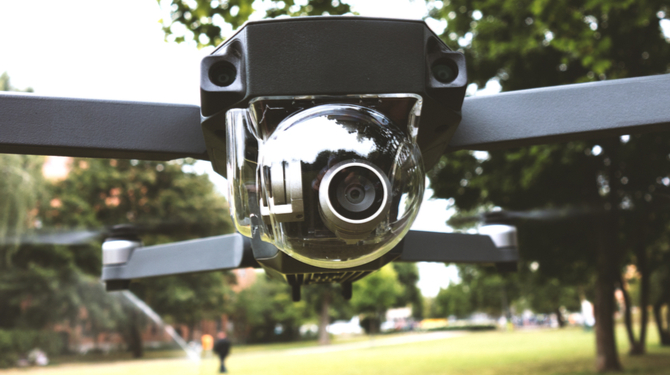According to Chris Andersonn, CEO of 3D Robotics in an interview with Forbes magazine, “Switzerland is the Silicon Valley of Robotics.” The magazine agreed, noting the country has “emerged as a serious competitor to California for the technologies, people and funding that will power the world’s fourth socio-economic revolution.”
Collaboration and talents
Many global companies are collaborating with Swiss universities and institutions. Swiss researchers are building everything from Tribot, a robot that can perform versatile search-and-rescue missions, to Ultra-fast, a robot arm that can quickly and accurately catch thrown objects. Chief among them Google, which is developing its technology platform called Tango, which enables devices to navigate without the need for GPS. Zurich boasts Google’s largest campus outside California, employing nearly 2,500 engineers, including more than 250 artificial intelligence specialists, with capacity to grow the total workforce there to 5,000. Google is a founding member of digitalswitzerland, an association working to position Switzerland as an international digital hub.
Events abound in the cities and mountains of the nation. The Swiss Robotics Day (see box) is an annual showcase for Swiss and international talent, while Switzerland was the location of the first “ Cybathlon,” and Olympic-style competition for disabled people using robotics-based assistive technologies, held in 2016 and organized by ETH Zurich. Sophia, a human-like robot developed by Hanson Robotics, was unveiled at “AI for Good,” a June 2017 global summit in Geneva for government, charity, industry and technology leaders to discuss AI's ethical, technical, societal and policy issues. Crypto Valley, the area around the Swiss city of Zug, is growing in status as the most Blockchain-friendly place in the world. The area includes open source blockchain-based computing platform Ethereum, bitcoin wallet and vault Xapo, and, the Monetas financial infrastructure platform. The latter two have relocated from North America.
Elsewhere, BestMile is enabling electric autonomous shuttles to circulate through a city center on both pedestrian areas and open roads, leveraging the potential of autonomous vehicles to tackle global mobility challenges. Another high profile effort is the MIRACLE project, under the leadership of Professor Philippe Cattin and Professor Hans-Florian Zeilhofer and funded with 15.2 million Swiss francs by the Werner Siemens Foundation , is pioneering on the boundary between natural sciences and medicine. MIRACLE stands for Minimally Invasive Robot-Assisted Computer-guided LaserosteotomE, and aims to develop a robotic endoscope to perform contact-free bone surgery with laser light.
EcoRobotix, a Swiss robotics firm, has been developing a robotic weeder that uses cameras and AI to spot weeds and kill them without affecting other crops. The solar-powered robot uses two arms to identify weeds and dispense herbicide. Because of its accuracy, the robot uses 20 times less herbicide than traditional weed-killing machines, claims EcoRobotix, which raised $10.6 million last month. The Swiss city of Lausanne has also recently been chosen as the European base of Rewired, a robotics-focused venture studio and fund that believes that improving sensory capabilities will unlock the next-generation of smart robotics and is investing in applied science and technologies that advance machine perception. The Swiss Federal Institute of Technology Lausanne (EPFL) is also working on “robot nerves” that can be used in smart clothes, as well as a robot nose to help in disaster management.
Despite only having 8.5m people, Switzerland has the world’s highest proportion of peer-reviewed scientific publications in relation to its population. The nation is highly multicultural nature, with foreigners making up more than 20% of the population and more than 60% having immigrant backgrounds. The country has been ranked for the past seven years as the world’s most innovative country by Cornell, the World Intellectual Property Organization and the INSEAD business school in Paris. KPMG said the Swiss are the world’s best-prepared for long-term change, which bodes well robotics and automation challenges modern societies. However, like other economies, the Swiss are lalso ooking at cutting labour costs. A Swiss fragrance maker has invested $60 million over three years into automation to increase its output by a third, while the chief executive of Ricola, the maker of a Swiss medicinal candy, said the company is trying to automate operations from its back office through production.
Legal ethics centre?
Switzerland is also a major centre for international legal institutions and law, and we can expect it to be the site of a great deal of talk about the ethical and legal implications of such Innovation. The most high profile of these are lethal autonomous weapons systems (LAWS), or what critics dub “killer robots.” Since 2014, diplomats, disarmament experts and civil society groups have met five times in the framework of the Convention on Certain Conventional Weapons (CCW) external link to discuss a range of ethical, legal, operational and technical challenges of LAWS. While countries agree that international law should apply to the future development of LAWS, there is still no common agreement on the exact definition of a killer robot or on the mechanism by which continued “human control” must be exercised over such a weapons system.
Several countries have committed to not acquiring or developing LAWS, and 22 countries support a pre-emptive ban. Meanwhile, campaigners warn that countries like the United States, China, Israel, South Korea, Russia and Britain are pushing ahead with the use and development of armed drones and other autonomous weapons systems with decreasing levels of human control. Ahead of the Geneva meeting, campaigners said the killer robot talks seemed to be going in the right direction. Maya Brehm of the Swiss branch of Article 36external link, a non-governmental organisation working to prevent weapons proliferation, said “We are clearly moving out of a technocratic debate into a political debate.”
Switzerland is very engaged in such diplomatic efforts, but is sceptical about a preventive ban at this stage and prefers a practical, and if necessary, regulatory measures to prevent any use of LAWS that would violate international law. Last year, it tabled a working paper entitled a “Compliance-based approach to Autonomous Weapons Systems external link” that reaffirms the importance of international law. Sabrina Dallafior, Switzerland’s ambassador to the UN in charge of disarmament issues, said “Ultimately, in terms of autonomous weapons, we have to decide whether we can delegate a life-or-death decision to a machine. We must agree on how much autonomy is acceptable or inacceptable. Acceptable or desirable autonomy could include weapons that are so precise that there’s no collateral damage or no civilian victims.” Parliamentarians Chantal Galladéexternal and Beat Flachexternal also filed questions urging the government to seek an international ban on LAWS. The Federal Council rejected both questions, arguing that it had “reservations” about a ban. Didier Burkhalter, foreign affairs minister at the time, said “all issues should be clarified” at the CCW before deciding on a possible ban.
Swiss Robotics Industry Day
The Swiss Robotics Industry Day, an annual event which this coming November will be the fifth, attracts over 90 world-renowned robotics companies giving around 70 poster sessions, 50 technology demonstrations an setting up 20 company booths. The event offers a platform for investment opportunities, state of the art technology spin-offs and SMEs, cutting edge technology demonstrations and future trends in robotics. The National Centre of Competence in Research (NCCR) Robotics is a Swiss nationwide organisation funded by the Swiss National Science Foundation pulling together top researchers from all over the country with the objective of developing new, human oriented robotic technology for improving our quality of life.
The Centre was opened on 1st December 2010, and binds together experts from five world-class research institutions; École Polytechnique Fédérale de Lausanne (EPFL) (leading house), Eidgenössische Technische Hochschule Zürich (ETH Zurich) (co-leading house), Universität Zürich (UZH), Istituto Dalle Molle di Studi sull’Intelligenza Artificiale (IDSIA) Lugano and University of Bern (UNIBE) for a period of up to 12 years. The 5th edition of the Swiss Robotics Industry Day will take place at the Swiss Tech Convention Centre, Lausanne, Switzerland, on Tuesday 5th of November 2019.
Drones
Sylvain Métille, a lawyer and course leader at UNIL in the Faculty of Law, Criminal Justice and Public Administration. Says “In Switzerland drones are at present considered more like toasters than robots because they do not fly unaided. Up to 30 kilos, a drone is not subject to any authorisation, but must remain within sight of its owner. It does not have the right to fly within 100 m of a crowd or 5 km of an airport. Public liability insurance is required if the drone weighs more than 500 g. Above 30 kilos, the rules that apply are the same as for a plane. So a framework does exist.” Since 2017, the Swiss Federal Office of Civil Aviation (FOCA) have offered manufacturers a certification procedure. The drone is viewed as a flying object that carries a risk of disrupting traffic, falling, causing damage and even killing someone. These risks exist independently of knowing whether the drone is autonomous or has a pilot.
Swiss Post ran delivery robot test runs between mid-October 2017 and January 2018 in Dübendorf, covering 800 kilometres without any accidents or incidents. Key findings were gained by Swiss Post and manufacturer Starship from almost 200 runs. Following successful deployment of the delivery robots with Jelmoli in Zurich city center, Swiss Post has now conducted tests in conjunction with the online contact lens provider discountlens.ch in Dübendorf in the Canton of Zurich. Andreas Hungerbühler, Managing Director of discountlens.ch, said “The needs of our customers are changing. They are more mobile and want goods ordered today to be with them as quickly as possible. This is why discountlens.ch is testing new delivery concepts, such as delivery by robot. Customers responded very positively to the new technology and wanted to try it out.”
If the robots are to be put to future use on Swiss streets without supervision, it is important to run tests autonomously. But due to the legal framework in Switzerland, this is not currently possible. Starship Technologies, the manufacturer of the delivery robots, aims to gather findings from fully autonomous operation at a variety of locations around the world. “We are happy to see Starship taking this step,” says Claudia Pletscher, Head of Development & Innovation at Swiss Post, commenting on the decision of the Estonian start-up. “We will be able to benefit from Starship’s experiences at a future point in time.” Swiss Post is testing new applications in parallel until the law in Switzerland changes to allow test runs to be performed without human supervision in public spaces. “We are concentrating at present on autonomous robots that can transport goods within buildings” said Ms Pletscher.
Robotic bankers
The country’s most traditional industry, the banking sector, has embraced the newcomer, with much attention was drawn to the replacement of seven employees by five robots. In a pilot project, St. Galler Kantonalbank AG opted to replace seven employees working for three days with the robots. SGKB’s test run was carried out in connection with the acquisition of M.M. Warburg Bank Schweiz AG’s private banking business, and involved the transfer of about 5,000 securities positions to its own IT systems. The bank said the five robots used did their job well. Felix Buschor, member of the management board, told Bloomberg, "We’ve seen that’s technically feasible and now we’re exploring whether other applications are worthwhile, and I’m very optimistic about that.” Mr Buschor estimated the cost for the first use of the software robots at between 20,000 and 30,000 Swiss francs, and believes future applications can include internal control processes or compliance.
The major Swiss banks UBS and Credit Suisse have been running a two-speed development, investing heavily in the automation of procedures. Two speed, because one But of the banks is still expanding its range robots, while the other has already decommissioned some of the machines. Also, while Credit Suisse chief executive Tidjane Thiam was very vocal about his vision to have as many as 400 robots at the disposal of his bank, UBS surpassed the vision when they introduced their 1,000th robot. Last year, UBS added 500 robots to its workforce last year, mostly in the back office. The robots are programmed to execute repetitive tasks and are due to reduce manual work by about 10 percent. The next frontier is the staff with robots, as UBS seeks to implement AI solutions in front-office roles, with robots to perform tasks related to trading strategy optimization.
According to a report by the Financial Times, the Swiss bank is about to take robots to trading floors. The company has shown how two AI solutions can assist traders in enhancing their performance. The first program, developed in collaboration with Deloitte, deals with clients’ post-trade allocation requests. The program scans for clients’ emails describing how they would like to allocate large block trades among funds. The system then processes the data and executes the transfers. According to UBS, the AI system performs a task that would usually take a person about 45 minutes in only about two minutes. The second of the new solutions uses machine learning to develop new strategies for trading volatility on behalf of clients. It scans vast amounts of trading data and creates a strategy based on learning from market patterns. The strategy, however, has then to be approved by human employees. Beatriz Martín Jiménez, chief operating officer of UBS’s investment bank, told the FT it would take “several years” before computers could be allowed to execute trades without them first being approved by human bankers.


.jpg)
.jpg)
.jpg)

.jpg)




